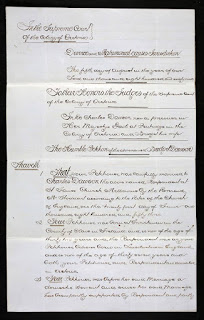Charles Henry Dawson was born in London in 1833 where he grew up with his family before they all immigrated to Australia, arriving in Port Phillip Bay, Victoria in August 1851. Within 2 years, he married Bridget Hogan at St James Church in Melbourne on 21 June 1853.
They settled in Myrniong having four children within 9 years. Bridget was a skilled dressmaker, while Charles tried his hand at a variety of jobs including the mounted police, a Labourer, a Digger and even a Cab & Dray driver. Not long after the birth of their fourth child, Charles and Bridget both agreed for Charles to head to Queensland in the pursuit of better employment prospects, with the expectation of him sending for her and the kids within three months. This was in August 1862 and it wasnt for another 6 years before Bridget set eyes on him again!Charles did write to Bridget after he left in 1862 however there was a two-year gap between the first letter and the second one. His inability to correspond was replicated with his inability to support his family. While Charles suggested that he had sent money, Bridget denied ever receiving any. She resorted to contacting their bank to enquire if there was any money deposited for her. There was none.
A chance sighting in New South Wales, around Christmas in 1865 exposed the rort. A mutual acquaintance of Charles & Bridget, Eliza Foster, spotted Charles with his new wife. When approached, Charles responded with a simple laugh, possibly a nervous reaction to being caught!
Bridget Dawson was informed of her husband’s whereabouts and “who-abouts”. According to the court transcript, she went to Melbourne and saw his second wife, confirming that the story was true. In February 1868 Charles was charged with bigamy, and a warrant for his arrest was issued.
Late April 1868, Bridget received a letter from Charles’ sister, begging her to forgive Charles. Three weeks later, Charles arrived home in Myrniong – the first time in 6 years. As soon as Bridget saw him, she asked a friend to contact the Police. Charles was remanded overnight, appearing at the Bacchus Marsh Court of Petty Sessions the following day. His case was heard, resulting in him being remanded to Melbourne for a trial in front of a jury at the Supreme Court.
The court case was listed for July 1868 before His Honor Mr Justice Redmond Barry (who presided over the Ned Kelly trial in 1880 and sentenced Ned to be hanged, then, himself suddenly passing away 12 days after Ned's hanging. Ironically, Justice Barry never himself married however had four children with Louisa Bridget Barrow, of whom he was very fond. Besides, Charles had enough marriages for them both! Look him up – he is a remarkable leader during early Victorian history.)
Details of the “somewhat peculiar” circumstances of the marriage were heard. On 25 July 1866, Charles married Ellen Mary Fitzgerald, a servant from the station where they were both working at Brookong Station near Jerilderie, NSW. This union produced a daughter the following March.
To add further intrigue, Charles was living under the alias “Charles Ellis” (“Ellis” being his mother’s maiden name). Rev. James John Annet, unfamiliar to the couple, was the officiating minister at their alleged marriage however he was later convicted of forgery due to his doctoring the certificate. Further irregularities included them having only one witness (not two as required by law) – James Brame, a cook from the station they worked on. The most bizarre occurrence at this wedding was the presence of a “novel on the table” instead of the obligatory bible!
Within a few minutes of deliberation by the jury, Charles was found guilty of Bigamy. He was sentenced to 2 years hard labour with his imprisonment to be served at Pentridge Stockade.
Divorce was granted late in 1869 with Bridget receiving custody of their four children. She remained in Myrniong, working as a dressmaker and raising her 4 children and died aged 52 years in June 1889, the same year her only daughter got married.

Comments
Post a Comment